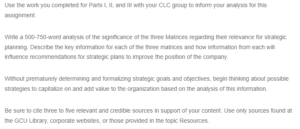Matrices Analysis Paper
BCG, SWOT, and IE matrices form major strategic tools applied by an organization to enhance competitiveness in the market. The three matrices are used to match internal organizational resources to external factors such as opportunities and risks. The three matrices can be used to maximize efficiency and effectiveness for a business. The critical information regarding each of the matrices is given below in relation to how the information influences Apple Inc.’s strategic plans.
The SWOT Matrix
The SWOT analysis is an acronym that stands for strengths, weaknesses, opportunities, and threats. The SWOT tool analyzes internal and external factors that influence a business. The strengths and weaknesses relate to internal influences, while opportunities and threats relate to external influences (Benzaghta et al., 2021). The SWOT matrix offers great insight into a company’s current state of affairs. The strengths, weaknesses, opportunities, and threats are identified and matched when preparing the matrix. The first match entails matching internal strengths and external opportunities. The second aspect matches internal weaknesses to external opportunities. Third, internal strengths are matched with external strengths and internal weaknesses are matched with external threats. The outcome of this matching is given as WO, SO, WT, and ST strategies.
The identified outcome strategies inform a business regarding the strategic direction to take to achieve strategic competitiveness. Drawing from the case of Apple Inc., the SO (strength-opportunities) strategies entail capitalizing on external opportunities and enhancing cutting-edge technology development. Regarding WO (weaknesses-opportunities) strategies, the company can expand its distribution networks using green technology and introduce smart wearable products. Concerning ST (strengths-threats) strategies, Apple Inc. can diversify its product portfolio and enhance compliance with laws to reduce lawsuits (Vlados, 2019). Finally, regarding WT (weaknesses-threats) strategies, the company can consider holding more assets as compared to liabilities and reducing employee turnover rates.
The BCG Matrix
The BCG matrix is Boston Consulting Group’s strategic tool for planning and allocating resources efficiently to diversified functions. Using the BCG matrix, an organization can craft strategies based on the information given by the matrix regarding which divisions are over-performing, which are performing averagely, and which are underperforming. The matrix does so by placing products and divisions in categories. Market growth is plotted on the y-axis, market share on the x-axis, and revenue is indicated as z. Circles are plotted in a bubble chart, each circle representing a division (Hossain & Kader, 2020). The bigger the circle, the more revenue is attributable to the circle. Notably, this information is vital in influencing the strategic position of Apple Inc. When the circle is bigger, Apple Inc. will consider the division important and concentrate on it as a strength to solidify the position of the company. On the other hand, smaller circles indicate areas from which Apple Inc. should strategize to withdraw funding since the matrix is a snapshot of the organization at a given time.
The Internal-External (IE) Matrix
The IE matrix places a company’s different segments in a display of nine cells. According to Amirshenava & Osanloo (2022), this matrix relies on weighted scores obtained from the external factors evaluation (EFE) and the evaluation of the internal factors (IFE) matrices to obtain the strategic position of an organization. The IE matrix enables an organization, just like the BCG matrix, to identify divisions of importance. The weighted scores identify the areas that require more attention from the business. For instance, Apple Inc. can implement strategies from the matrix identified by analyzing the cells relating to harvesting, dividing, holding, maintaining, growing, and building. A company’s strategic plan should emphasize developing the weaknesses identified and exploiting the strengths identified. Additionally, there should be plans to thwart external threats and overcome competition.
References
Amirshenava, S., & Osanloo, M. (2022). Strategic planning of post-mining land uses: A semi-a quantitative approach based on the SWOT analysis and IE matrix. Resources Policy, 76, 102585.
Benzaghta, M. A., Elwalda, A., Mousa, M. M., Erkan, I., & Rahman, M. (2021). SWOT analysis applications: An integrative literature review. Journal of Global Business Insights, 6(1), 55-73.
Hossain, H., & Kader, M. A. (2020). An analysis of BCG growth sharing matrix. International Journal of Contemporary Research and Review, 11(10).
Vlados, C. (2019). On a correlative and evolutionary SWOT analysis. Journal of Strategy and Management. https://doi.org/10.1108/JSMA-02-2019-0026.
ORDER A PLAGIARISM-FREE PAPER HERE
We’ll write everything from scratch
Question 
Use the work you completed for Parts I, II, and III with your CLC group to inform your analysis for this assignment.

Matrices Analysis Paper
Write a 500-750-word analysis of the significance of the three Matrices regarding their relevance for strategic planning. Describe the key information for each of the three matrices and how information from each will influence recommendations for strategic plans to improve the position of the company.
Without prematurely determining and formalizing strategic goals and objectives, begin thinking about possible strategies to capitalize on and add value to the organization based on the analysis of this information.
Be sure to cite three to five relevant and credible sources in support of your content. Use only sources found at the GCU Library, corporate websites, or those provided in the topic Resources.